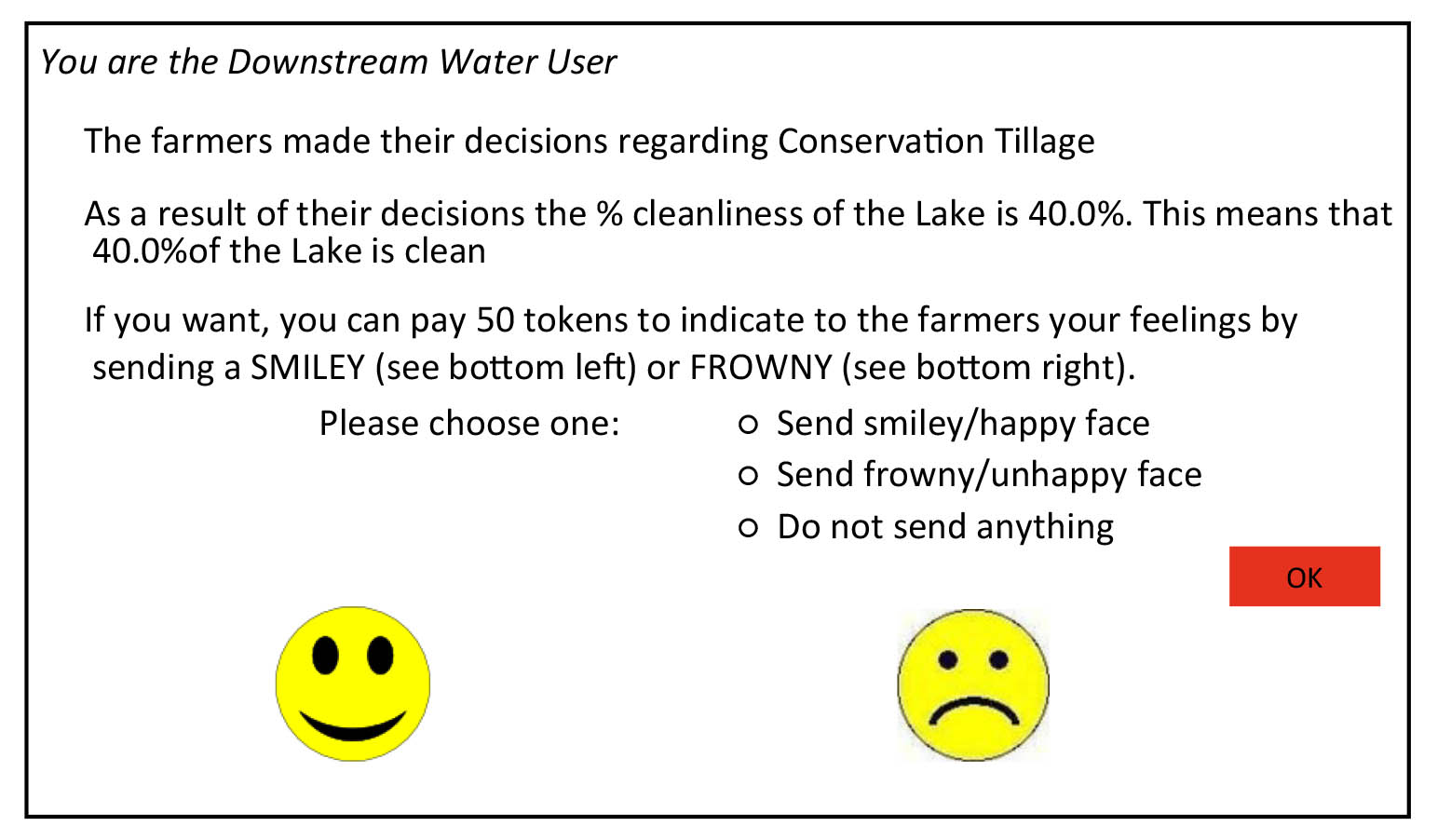Cornhusker Economics September 23, 2015Downstream Pollution: Do Gender and Emotion Matter?
Gender differences are a subject of interest to many disciplines, including economics when it comes to strategic behavior, environmental studies when it comes to environmental attitudes and behavior, and psychology when it comes, among many other topics, to differences in emotion expression and reaction. To study a number of questions related to conservation decisions in the context of downstream water pollution, including gender differences and effect of emotions, a laboratory experiment was conducted in the Experimental and Behavioral Economics Laboratory of the Department of Agricultural Economics at the University of Nebraska-Lincoln. In total 216 students and members of the public participated in the experiment, with 45% being females. The experiment was incentive compatible and the participants earned on average $28.90 depending on their choices during the game.
The game was developed in the context of water quality that affected the downstream water users. In this game, the upstream farmers and the players with the dual role (playing simultaneously upstream farmers and water users) choose how much of their land to put under conservation tillage. The level of conservation impacted the water quality downstream as well as the profits of the downstream water users. After farmers make their decisions, the downstream water users had an opportunity to express their feelings, i.e., to provide emotional feedback, on the level of cleanliness/pollution of the lake. The water users could send a smiley face, a frowny face, or offer no feedback (see Figure 1). Providing feedback was costly, albeit not very expensive. After receiving the emotional feedback from the water users, the farmers had to choose the level of conservation tillage again.

Three treatments were considered in the experiment: Empathy, Self-interest, and Neutral. Empathy and Self-interest treatments used loaded language, where in Empathy treatment subjects were nudged towards more empathetic behavior (i.e., projecting themselves into the situation of others and of impact on the environment), while in Self-interest treatment, subjects were nudged towards more selfish behavior (i.e., thinking only of themselves and their profits). Neutral treatment was written in a context-free language.
In this article, we report the results on gender differences in (i) willingness to send an emotional feedback, and (ii) responding to emotional feedback. It is a common perception that females are more emotional in general, while males might be more emotional in aggressive emotions, such as anger. The data of our experiment showed that males sent more positive and negative emotions than females in loaded treatments, while females sent more in neutral framing. Analyzing the data further, we found that the decision to express emotions depends on the level of water pollution, rather than the treatment or gender. Regarding the reaction to emotional feedback, gender differences were more pronounced among the upstream farmers than among the players with the dual role. Additionally, positive emotions led to more selfish behavior, while negative emotions triggered more response among males than females. That is, males increased their conservative tillage technology by more than females after receiving a frowny face (see Figure 2).

Thinking in terms of reward and punishment, the results showed that in self-interest treatment both genders were willing to punish more when water quality was low; thus, the decision was outcome driven. Our results also demonstrated that emotional punishment/social disapproval was more effective in promoting fairness in both males and females, but especially in males. In conclusion, even if there are no gender differences in expressing of emotions, there are differences in reacting to emotions.
Economic experiments are increasingly becoming a popular tool to study pro-environmental and conservation behavior. The better we understand what triggers this behavior and how people respond to change in pecuniary and non-pecuniary incentives and nudges, the better we will be able to tailor environmental policies. Furthermore, understanding the differences in behavior between women and men should result in better policy-making. Smiley and frowny faces or an expression of other positive and negative emotions can be considered as non-pecuniary nudges, representing rewards or punishment and social (dis)approval.
This article is based on:Khachaturyan M. Dissertation (2014) Transboundary Waters: Using Game Theory in Theoretical and Experimental Studies to Analyze the Management of Upstream- Downstream Water Problems, Chapter “Gender Effects in Environmental Decisions and Emotions”, pp. 1-79.
Dr. Marianna Khachaturyan
Dept. of Agricultural Economics Alumna
University of Nebraska-Lincoln
marianna@huskers.unl.edu
Dr. Natalia Czap, Assoc. Professor of Economics
Dept. of Social Sciences
University of Michigan-Dearborn
nczap@umich.edu
Dr. Gary D. Lynne, Professor Emeritus
Dept. of Agricultural Economics
University of Nebraska-Lincoln
glynne1@unl.edu